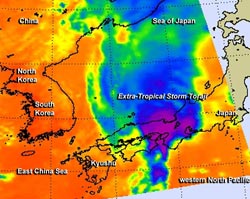Infrared NASA Image Sees Extra-Tropical Toraji Over Japan

NASA's AIRS instrument data took this infrared image of Tropical Storm Toraji as it continued tracking through southern Japan on Sept.4 at 0429 UTC. Purple indicate coldest cloud top temperatures and strongest thunderstorms with heaviest rainfall. Image Credit: NASA JPL/Ed Olsen<br>
The Atmospheric Infrared Sounder or AIRS instrument captured infrared data of Extra-Tropical Storm Toraji as it continued tracking through southern Japan on Sept.4 at 0429 UTC/12:29 a.m. EDT.
AIRS showed that the coldest cloud top temperatures and strongest thunderstorms with heaviest rainfall stretched from Hyogo Prefecture in the southwest to Shiga Prefecture to Gifo Prefecture in the northeast.
At 1500 UTC/11 a.m. EDT on Sept. 4, Toraji had maximum sustained winds near 40 knots/46 mph/74 kph. It was centered near 32.7 north and 132.9 east, about 114 nautical miles/131 miles/211 km south of Iwakuni, Japan. Toraji has increased in forward speed over the last day and was moving to the northeast at 22 knots/25.3 mph/40.7 kph.
The Joint Typhoon Warning Center's multi-level analyses indicated that Toraji is now an extra-tropical cold-core low pressure area, and it is linked to a fast moving frontal boundary. That frontal system is moving across Japan and will carry Toraji's energy with it.
Text credit: Rob Gutro
NASA's Goddard Space Flight Center
Media Contact
All latest news from the category: Earth Sciences
Earth Sciences (also referred to as Geosciences), which deals with basic issues surrounding our planet, plays a vital role in the area of energy and raw materials supply.
Earth Sciences comprises subjects such as geology, geography, geological informatics, paleontology, mineralogy, petrography, crystallography, geophysics, geodesy, glaciology, cartography, photogrammetry, meteorology and seismology, early-warning systems, earthquake research and polar research.
Newest articles

Superradiant atoms could push the boundaries of how precisely time can be measured
Superradiant atoms can help us measure time more precisely than ever. In a new study, researchers from the University of Copenhagen present a new method for measuring the time interval,…

Ion thermoelectric conversion devices for near room temperature
The electrode sheet of the thermoelectric device consists of ionic hydrogel, which is sandwiched between the electrodes to form, and the Prussian blue on the electrode undergoes a redox reaction…

Zap Energy achieves 37-million-degree temperatures in a compact device
New publication reports record electron temperatures for a small-scale, sheared-flow-stabilized Z-pinch fusion device. In the nine decades since humans first produced fusion reactions, only a few fusion technologies have demonstrated…





















